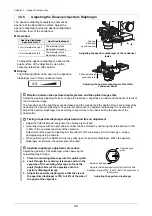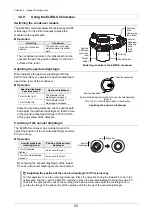
Chapter 3 Usage of Components
41
3.4 Using the Condenser Section
3.4.1 Selecting a Suitable Condenser
The following four types of condensers can be used with this microscope:
Select a condenser suitable for microscopy.
Condenser turret (system condenser)
Up to seven condenser modules can be attached.
Microscopy techniques can be switched by turning
the turret to change the condenser module.
The condenser lens is replaceable and a range of
lenses is available for the applicable microscopy.
Condenser turret (system condenser)
ELWD-S condenser
This condenser allows BF microscopy and Ph
microscopy. Manually turn the turret to select optical
elements.
Note: An ELWD condenser lens, which cannot be
replaced, is mounted on the ELWD-S
condenser.
ELWD-S condenser
HNA condenser slider
A high-magnification DIC or Ph microscopy (or BF
microscopy) is available in combination with a high
NA condenser lens. Manually pull in or pull out the
slider using the slider in/out levers to select a
condenser module.
Two types of high NA condenser lenses can be used:
•
TI2-C-LHD HNA dry lens
•
TI2-C-LHO HNA oil lens
Note: A high NA lens is required for using the HNA
condenser slider.
HNA condenser slider
DF condenser
This is a condenser exclusively for DF microscopy.
There are two types of condensers and mounted
immediately under the TI-DF condenser adapter.
•
Darkfield condenser oil
•
Darkfield condenser dry
DF condenser
Condenser lens
Turret
Centering knob
clamp screw
(both sides)
Condenser
centering screw
(both sides)
Aperture diaphragm
lever
DF condenser
TI-DF Dark-Field
Condenser
Adapter
Extension tube
(supplied with the
high NA lens)
Slider in/out lever
(both sides)
Slider
Aperture
diaphragm lever
Dust-proof
plate
High NA condenser lens
Aperture
diaphragm lever
Condenser lens
Condenser
module indication
Condenser module
replacement port
Turret
Module centering
screws
(both sides)
















































